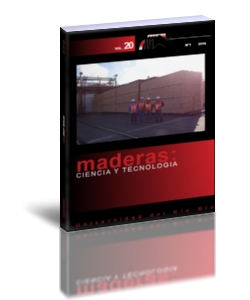Surface roughness of thin wood veneers sliced from laminated green wood lumber
Keywords:
Cinnamomum camphora, Cunninghamia lanceolate, finger joints, high moistureAbstract
Freshly-felled Chinese fir (Cunninghamia lanceolate), Masson Pine (Pinus massoniana) and Camphor Tree (Cinnamomum camphora) logs were reconstituted to form laminated lumber with moisture content above fiber saturation point by slicing, finger-jointing, gluing, and cold-pressing processes. The laminated lumber was then sliced into wood veneers, which were air-dried to about 15% moisture content. The surface roughness of the veneer was tested in comparison with two commercial engineered wood veneers using a stylus tracing method. The influence of the wood surface roughness was relatively small for the wood species chosen due to their similar densities. All roughness parameter values were consistently larger along the transverse direction compared with these along longitudinal direction. The values of surface roughness at the finger-joint region were higher than these that at the non-finger-joint region along both longitudinal direction and transverse direction. The two engineered wood veneers had surface roughness values noticeably smaller in the longitudinal direction, but their values in transverse direction were comparable and even larger compared with these of the prepared wood veneers including both non-finger-joint and finger-joint regions. Overall, the process of laminating finger-jointed green wood planks and subsequently slicing can be used to yield acceptable wood veneers with sufficient surface quality.
Downloads
References
Brémaud, I.; Gril, J,; Thibaut, B. 2011. Anisotropy of wood vibrational properties: dependence on grain angle and review of literature data. Wood Sci Technol 45:735-754.
Budakci, M.; Gurleyen, L.; Cinar, H.; Korkut, S. 2007. Effect of Wood Finishing and Planing on Surface Smoothness of Finished Wood. J Appl Sci 7:2300-2306.
Coelho, C.L.; Carvalho, L.M.H.; Martins, J.M.; Costa, C.A.V.; Masson, D.; Meausoone,
P. J. 2008. Method for evaluating the influence of wood machining conditions on the objective characterization and subjective perception of a finished surface. Wood Sci Technol 42:181-195.
Csanády, E.; Magoss, E.; Tolvaj, L. 2015. Surface Roughness of Wood. In: Quality of Machined Wood Surfaces. Springer International Publishing. Cham, pp 183-236. ISBN:978-319-22418-3.
de Moura, G. P.; de Figueired, J. V.; de Moura, L F.; Nolasco, A M.; de Carvalho, A. M.; Garcia, R. A. 2014. Surface roughness of heat treated Eucalyptus grandis wood. Maderas-Cienc Tecnol 16(1): 3 -12.
Deng, H.; Liu, Y. 2010. Study on Environmental-Friendly Dyeing Processes of Fast-Growing Plantation Veneers. In: 2010 4th International Conference on Bioinformatics and Biomedical Engineering. IEEE, pp 1-4.
Dumitrascu, A.E.; Ciobanu, V.D.; Lepadatescu, B. 2013. Valorization of Wood Resources for the Cutting of Decorative Veneer in the Context of Sustainable Development of Romanian Forests. BioResources 8:4298-4311.
Dundar, T.; Ayrilmis, N.; Candan, Z. 2008. Evaluation of surface roughness of laminated veneer lumber (LVL) made from beech veneers treated with various fire retardants and dried at different temperatures. For Prod J 78:71-76.
Hendarto, B.; Shayan, E.; Ozarska, B.; Carr, R. 2006. Analysis of roughness of a sanded wood surface. Int J Adv Manuf Technol 28:775-780.
Hiziroglu, S. 1996. Surface roughness analysis of wood composites: A stylus method. For Prod J 46:67-69.Kilic, M.;
Hiziroglu, S.; Burdurlu, E. 2006. Effect of machining on surface roughness of wood.Build Environ 41:1074-1078.
Li, G.; Lv, Z.; Liu, Z. 2015. A preliminary study on the main mechanical properties of the high moisture content wood after finger-jointed. J Northwest For Univ 30:224-227.
Liu, Z.; Li, Y.; Du, C.; Zhang, Y. 2003. A study on production technology of sliced bamboo veneer. J Zhejang For Coll 20:227-231.
Magoss, E. 2008. General Regularities of Wood Surface Roughness. Acta Silvatica et Lignaria Hungarica 4:81-93.
Malkoçoğlu, A. 2007. Machining properties and surface roughness of various wood species planed in different conditions. Build Environ 42:2562-2567.
Peng, L.; Wang, J. 2004. A study on processing edge jointed veneer. China Wood Ind 18:72-76.
Sulaiman, O.; Hashim, R.; Subari, K.; Liang, C.K. 2009. Effect of sanding on surface roughness of rubberwood. J Mater Process Technol 209:3949-3955.
Wang, M.; Wang, J.; Li, L. 2005. Roughness and roughness sense of wood surface from different machining processes. Journal Beijing Forestry University 27:14-18.
Yu, W.; Yu, Y. 2013. Development and prospect of wood and bamboo scrimber industry in China.
China Wood Industry 27:5-8.
Zhong, Z.W.; Hiziroglu, S.; Chan, C.T.M. 2013. Measurement of the surface roughness of wood based materials used in furniture manufacture. Measurement 46 1482-1487.

































